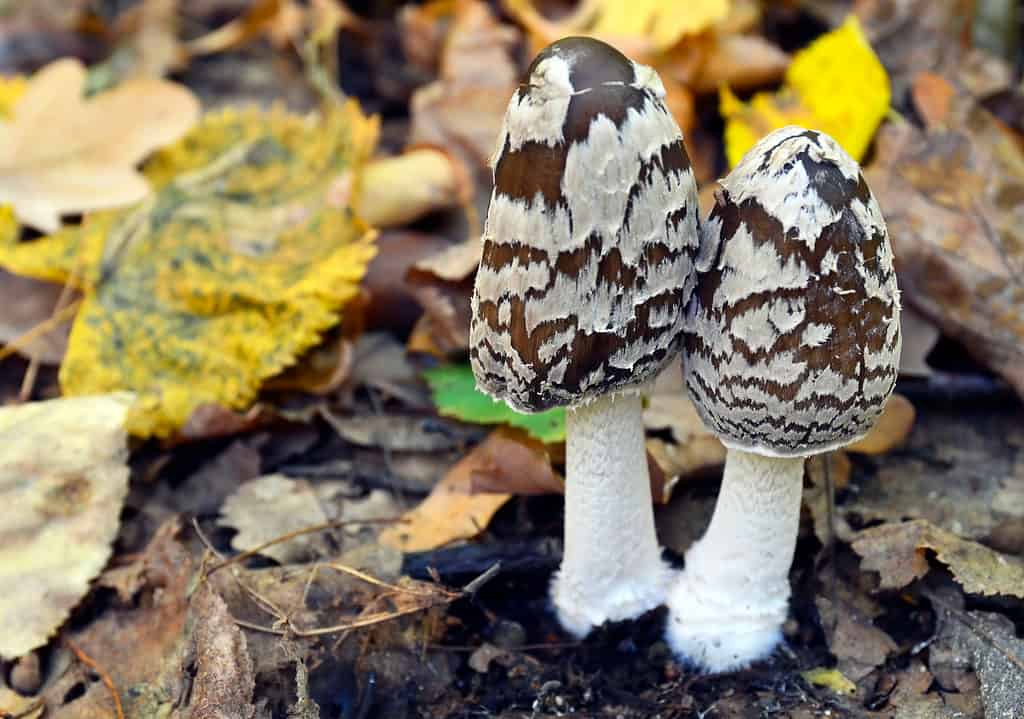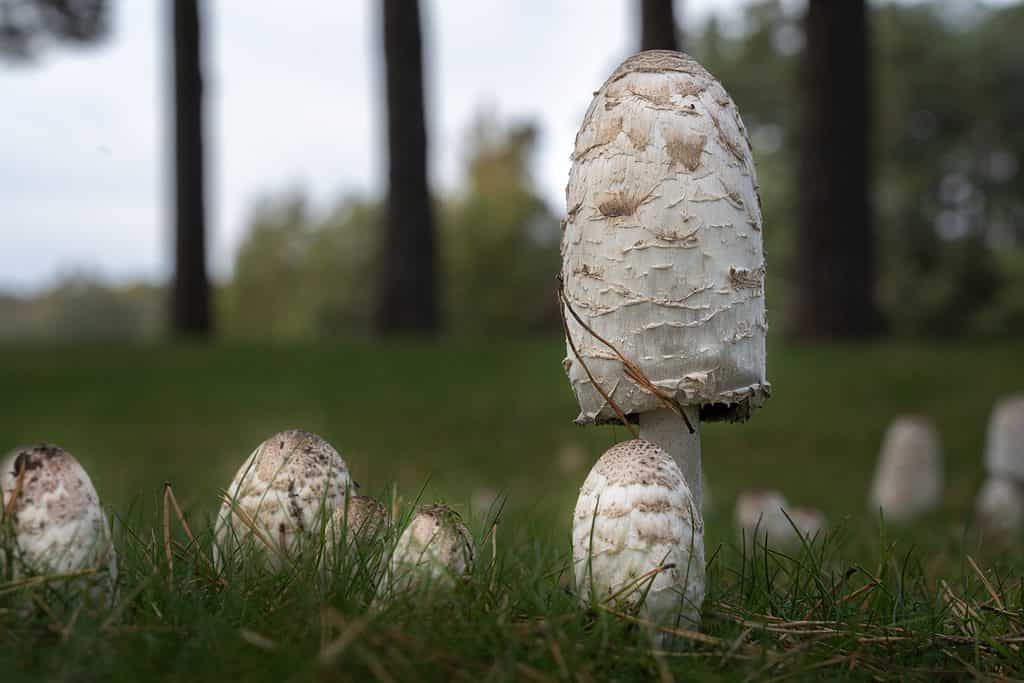If you’ve ever seen a cluster of mushrooms with caps that look like they’re melting away, dripping with a thin black liquid, then you’ve likely found inky cap mushrooms! These strange, beautiful mushrooms occur in temperate regions around the world, especially in North America and Europe.
In this guide, we’ll cover which genera fall under the inky cap grouping, what characteristics inky caps share, name some well-known edibles, and explain why these wonderfully strange fungi liquefy.
So, without further ado, let’s dive in!
Inky Cap Mushrooms: Fungal Classification
The name “inky cap” describes hundreds of species of mushrooms across several genera. What these mushrooms have in common is that they all liquefy upon spore maturity.
Originally, all mushrooms that displayed this spore dispersal strategy (which we’ll dive into later in this guide), were grouped into the genus Coprinus.
However, based on some distinct morphological differences and genetic analysis, researchers in 2001 split this genus into four distinct genera: Coprinus, Parasola, Coprinopsis, and Coprinellus.
Not only are inky caps not all in the same genus, but some are not even in the same fungal family. Indeed, inky caps in the Coprinus genus belong to the Agaricaceae family, while inky caps in the Coprinopsis, Coprinellus, and Parasola genera all belong to the Psathyrellaceae family.
Rather than being closely related, many inky cap mushrooms look the same and have the same spore dispersal strategy due to convergent evolution. This process describes when unrelated or distantly related species evolve similar features and survival strategies due to facing the same environmental pressures.
Inky Cap Mushrooms: How They Get Their Name
So, the most obvious trait that all inky caps have in common is their spore dispersal strategy which involves liquifying their entire caps in a process known as deliquescence. In this messy process, the inky cap, once it reaches maturity, begins to break down its cap from the bottom up, also known as auto digestion.
This auto-digestion occurs through hydrolytic enzymes produced by the mushroom. Normally, these enzymes are used to digest complex organic compounds into nutrients for the mycelium.
However, in deliquescence, the enzymes break down the gills and cap of the mushroom. Specifically, the enzyme responsible for this process is chitinase. You may know that mushrooms contain chitin, a complex sugar that gives mushroom bodies their structure.
Now, chitinase breaks down chitin, but it is only produced about two hours before the mushroom releases its spores, and it is only found in the gills and cap of the mushroom. Spores also contain chitin but appear to be unharmed by chitinase, with some mycologists theorizing that this is due to the protective, layered structure of spore cells.
So, just before spore release, chitinase begins breaking down the cap and gills of the inky cap, resulting in a slurry of black liquid and spores. The current understanding of the benefit of this strategy is that as the cap dissolves, peeling up and away from the gills, mature spores are left exposed to catch air currents, thus increasing their chance of successful dispersal. It is likely that this spore dispersal strategy is the essence of deliquescence.

©Edwin Butter/Shutterstock.com
Inky Caps by Genus
As we mentioned earlier, inky caps are currently divided into four separate genera: Coprinus, Parasola, Coprinopsis, and Coprinellus. We’ll cover some common characteristics of species in each genus.
Coprinus
Coprinus, the genus that initially included hundreds of species of inky caps that mycologists later subdivided, now encompasses only three species: Coprinus comatus, Coprinus sterquilinus, and Coprinus spadiceosporus.
The defining characteristic of these three species is that mature specimens have a partial veil ring around the upper stipe, young gills are often pinkish, and the hollow stipe contains string-like fibrous strands.

©Rita Romanyshyn/Shutterstock.com
Coprinopsis
When the Coprinus genus was divided in 2001, mycologists reclassified the majority of species in the genus into Coprinopsis. Currently, Coprinopsis contains about 200 species of inky caps. Some well-known species include Coprinopsis cinera, Coprinopsis atramentaria, and Coprinopsis picacea.
Species in Coprinopsis are difficult to distinguish from Coprinellus, but often have more defined veil remnants on the caps.

©svf74/Shutterstock.com
Coprinellus
The genus Coprinellus represents about 80 species of inky caps in the Psathyrellaceae family. Coprinellus micaceus, Coprinellus disseminatus, and Coprinellus domesticus.
You can identify if an inky cap belongs to this genus by looking for ozonium, a mat of orange fibrous mycelium that occurs around the stipe base. This mat is quite noticeable when the mushrooms fruit in clusters. Another characteristic of Coprinellus inky caps is the appearance of veil remnant flecks on the caps, referred to as granules.

©Kazakov Maksim/Shutterstock.com
Parasola
The fourth and final genus of inky caps is Parasola, which currently includes 18 species. The most well-known of Parasola inky caps include Parasola plicatilis, Parasola conopilea, and Parasola leiocephala.
This genus of inky caps is characterized by very small, fragile mushrooms that often have translucent caps. Many of the species are nearly impossible to distinguish without a microscope. Parasola inky caps have umbrella-shaped caps that are deeply grooved. Unlike some other inky caps, like Coprinus comatus, mature specimens of this genus do not have remnants of a universal veil. Species of Parasola occur in temperate and subtropical regions worldwide with most occurring in Europe and North America. These inky caps are saprobic decayers of leaf litter, herbivore manure, and rotted wood.

©nomis_h/Shutterstock.com
Well-Known Edible Inky Caps
So, two of the most well-known edible inky caps are Coprinus comatus, and Coprinopsis atramentaria. We’ll describe them in detail below and explain how Coprinus atramentaria is conditionally edible.
Coprinus comatus
When picked before this mushroom starts the process of deliquescence, Coprinus comatus, also known as the shaggy mane mushroom, is a well-regarded edible.
The shaggy mane mushroom, like other inky caps, is saprobic, meaning it derives its nutrients from dead organic matter. Typically inky caps grow on herbivore manure, wood chips, leaf litter, etc. However, they do not grow on solid wood substrates such as non-rotten logs or stumps.
You can often find shaggy manes growing along roadsides, in lawns, flower beds, and disturbed, compacted areas such as walking trails.
To identify shaggy manes suitable to eat, look for specimens that have not yet begun deliquescence. Ideal specimens have shaggy cream-white caps shaped like a nearly closed umbrella. The upright, slender, cream-white stipes have a ring around the upper portion. The young gills are white, notably crowded, and not attached to the stipe. The spore print is black.
You’ll want to cook these mushrooms immediately after harvesting as picking them triggers their auto-digestion process.

©UKSTUDIO/Shutterstock.com
Coprinopsis atramentaria
So, unlike, shaggy manes, the edibility of Coprinopsis atramentaria is conditional. This mushroom, also known as the common inky cap and tippler’s bane, is a perfectly good edible unless consumed with or within 48 hours of consuming alcohol.
This conditional toxicity is due to the presence of coprine in Coprinopsis atramentaria. Coprine is a mycotoxin that, when combined with alcohol, causes alcohol intolerance.
Symptoms appear 20 minutes to two hours after ingestion and can last up to three days. These symptoms can include flushing, dizziness, vomiting, nausea, and headache. Typically, symptoms resolve on their own and treatment involves supportive care like staying hydrated.
While you certainly don’t want to consume this mushroom in conjunction with alcohol, it does otherwise make for a delicious and safe edible.
You can find the common inky cap growing in temperate regions across North America and Europe. These mushrooms often grow in clusters, and as saprobic fungi, you’ll find them growing on decaying organic matter such as wood chips, herbivore manure, and leaf litter.

©bogdan ionescu/Shutterstock.com
The cap on the young common inkcap is also shaped like a nearly closed umbrella, which expands outward to a more flared convex shape with age. Once deliquescence sets in, the cap starts to dissolve upwards from the margin. Young specimens have lead gray to gray-brown caps with slightly grooved margins. The spore print is black.
Up Next
- Red Pine Mushrooms: A Complete Guide
- False Morel Mushrooms: A Complete Guide
- Hen of the Woods Mushrooms: A Complete Guide
The post Types of Inky Cap Mushrooms appeared first on AZ Animals.
from Animal News, Facts, Rankings, and More! - AZ Animals https://ift.tt/TGLdDkQ